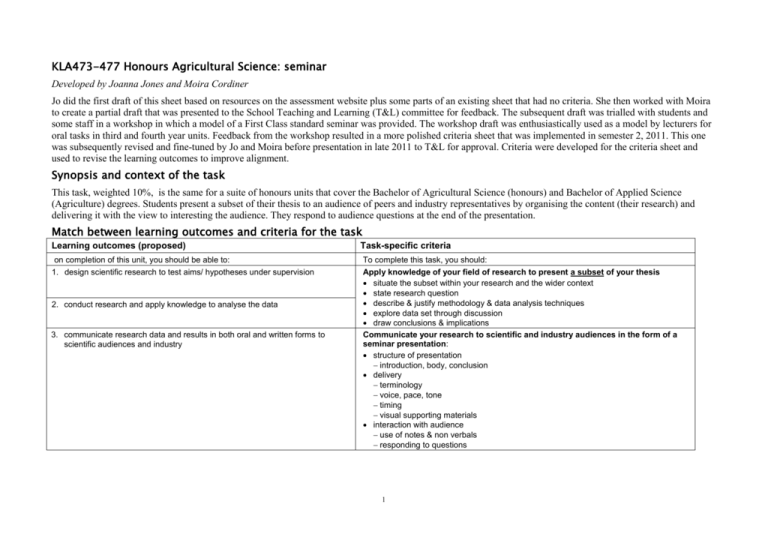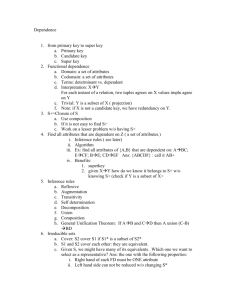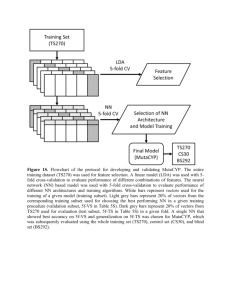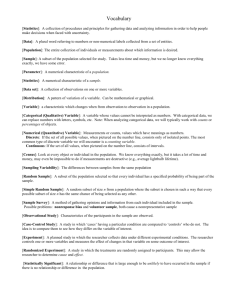Honours Agricultural Science seminar
advertisement

KLA473-477 Honours Agricultural Science: seminar Developed by Joanna Jones and Moira Cordiner Jo did the first draft of this sheet based on resources on the assessment website plus some parts of an existing sheet that had no criteria. She then worked with Moira to create a partial draft that was presented to the School Teaching and Learning (T&L) committee for feedback. The subsequent draft was trialled with students and some staff in a workshop in which a model of a First Class standard seminar was provided. The workshop draft was enthusiastically used as a model by lecturers for oral tasks in third and fourth year units. Feedback from the workshop resulted in a more polished criteria sheet that was implemented in semester 2, 2011. This one was subsequently revised and fine-tuned by Jo and Moira before presentation in late 2011 to T&L for approval. Criteria were developed for the criteria sheet and used to revise the learning outcomes to improve alignment. Synopsis and context of the task This task, weighted 10%, is the same for a suite of honours units that cover the Bachelor of Agricultural Science (honours) and Bachelor of Applied Science (Agriculture) degrees. Students present a subset of their thesis to an audience of peers and industry representatives by organising the content (their research) and delivering it with the view to interesting the audience. They respond to audience questions at the end of the presentation. Match between learning outcomes and criteria for the task Learning outcomes (proposed) on completion of this unit, you should be able to: 1. design scientific research to test aims/ hypotheses under supervision 2. conduct research and apply knowledge to analyse the data 3. communicate research data and results in both oral and written forms to scientific audiences and industry Task-specific criteria To complete this task, you should: Apply knowledge of your field of research to present a subset of your thesis situate the subset within your research and the wider context state research question describe & justify methodology & data analysis techniques explore data set through discussion draw conclusions & implications Communicate your research to scientific and industry audiences in the form of a seminar presentation: structure of presentation introduction, body, conclusion delivery terminology voice, pace, tone timing visual supporting materials interaction with audience use of notes & non verbals responding to questions 1 Student name: Student number: Task name: Honours Seminar criteria First class Marks /100 Apply knowledge of your field of research to present a subset of your thesis situate the subset within your research and the wider context state research question describe & justify methodology & data analysis techniques explore data set through discussion draw conclusions & implications weighting 50% 2. communicate research ideas and outcomes to scientific and industry audiences in the form of a seminar presentation: structure of presentation introduction, body, conclusion weighting 10% Second uppers range: 100-80 Marks /100 Second lowers 79-70 Marks /100 69-60 Third Class Marks /100 59-50 In your seminar presentation, you: In your seminar presentation, you: In your seminar presentation, you: In your seminar presentation, you: applied comprehensive knowledge of your field of research to present a subset of your research by: accurately situating it within this field and the wider context (e.g. industry) applied knowledge of your field of research to present a subset of your research by: accurately, for the most part, situating it within this field and the wider context (e.g. industry) explicitly stating the subset research question and outlining the scope applied knowledge of your field of research to present a subset of your research by: partly situating it within this field and the wider context (e.g. industry) applied basic knowledge of your field of research to present a subset of your research by: situating it broadly within this field stating the subset research question and outlining the scope stating the subset research question and partially outlining the scope describing in detail your research methodology & data analysis, and justifying these choices describing in some detail components of your research methodology & data analysis, and partially justifying these choices partially exploring the selected data set in discussion through: analysis of processed and synthesised results with only minor mistakes interpretation in relation to relevant literature and/or ideas in the field explanation of problems encountered and how these were dealt with drawing relevant conclusions: relating them back to your research question evaluating the contribution to the field posing some directions for further research outlining a research methodology and analysis technique/s communicated your research to scientific and industry audiences through: communicated your research to scientific and industry audiences through: organising the content into a delineated introduction, body and conclusion and using some cohesive ties organising the content into an introduction, body and conclusion and using some cohesive ties explicitly stating the subset research question and thoroughly defining the scope describing in essential detail your research methodology & data analysis, and persuasively justifying these choices perceptively exploring the selected data set in discussion through: critical analysis of processed and synthesised results correct interpretation in relation to relevant literature and/or ideas in the field thorough explanation of problems encountered and how these were innovatively dealt with drawing relevant and plausible conclusions: clearly relating them back to your research question insightfully evaluating the quality of your research and its contribution to the field posing valid directions for further research confidently and skilfully communicated your research to scientific and industry audiences through: concisely organising the content into a clearly delineated introduction (including ‘hook’), body and conclusion and effectively using cohesive ties exploring the selected data set in discussion through: critical analysis of processed and synthesised results correct interpretation in relation to relevant literature and/or ideas in the field thorough explanation of problems encountered and how these were logically dealt with drawing relevant and plausible conclusions: clearly relating them back to your research question evaluating the quality of your research and its contribution to the field posing mostly valid directions for further research confidently communicated your research to scientific and industry audiences through: logically organising the content into a clearly delineated introduction, body and conclusion and effectively using cohesive ties 1 partly exploring the selected data set through: fundamental analysis of processed and synthesised results initial interpretation with general reference to relevant literature and/or ideas in the field describing problems encountered and how these were dealt with drawing relevant conclusions: tenuously relating them back to your research question making broad but correct generalisations about the contribution to the field stating a direction for further research Student name: Student number: Task name: Honours Seminar criteria weighting 10% First class Marks /100 delivery terminology voice, pace, tone timing visual supporting materials interaction with audience use of notes & non verbals responding to questions weighting 50% Second uppers range: 100-80 delivering content by: using extensive, correct and relevant terminology, and simply explaining unfamiliar discipline- or industry-specific terms Second lowers 79-70 Marks /100 delivering content by: Third Class 69-60 delivering content by: using correct and relevant terminology, explaining unfamiliar discipline- or industry-specific terms using correct and relevant terminology, and occasionally explaining unfamiliar discipline- or industry-specific terms being consistently audible with correct pronunciation and varying volume, intonation, pitch and pace to generate audience interest being audible with correct pronunciation, and at times varying volume, intonation and pitch, while maintaining the same pace throughout, to generate some audience interest meeting the given time frame using a minimal number of welldesigned PowerPoint slides that enhanced the presentation and assisted the audience’s understanding interacted with, and kept the audience’s attention, by: minimally referring to prepared notes, maintaining eye contact with the audience, using suitable gestures and facial expressions and using an open, relaxed posture responding to audience questions in a polished manner, with a conversational tone through, e.g. knowledgeably clarifying content and/or defending a position making plausible suggestions or valid assumptions Comments, grade and mark Marks /100 Criterion 1: /100 using well – designed Power-Point slides that enhanced the presentation and assisted the audience’s understanding interacted with the audience by: using mostly well-designed PowerPoint slides that complemented the presentation interacted with the audience by: minimally referring to prepared notes, maintaining eye contact with the audience, occasionally using suitable gestures, and mostly using an open, relaxed posture referring to prepared notes, mostly maintaining eye contact with the audience, occasionally gesturing and using an open, relaxed posture responding to the audience with a conversational tone, through, e.g. responding to the audience, through, e.g. clarifying content and/or defending a position making sensible suggestions or valid assumptions Criterion 2: /100 Total: 2 partially clarifying content and/or defending a position making suggestions or valid assumptions /200 Final percentage: Marks /100 59-50 delivering content by: using mostly correct and relevant terminology being audible with mostly correct pronunciation, with a pace that is too fast OR a mix of fast and slow pace using PowerPoint slides to support the presentation partially interacted with the audience by: constantly relying on prepared notes; occasionally making eye contact and gesturing; maintaining a fixed facial expression and closed posture broadly responding to audience questions, through, e.g. stating a position making suggestions or assumptions / 10% 3







